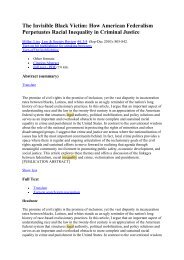Ski – resort and regional development: profile of visitors ... - E-Journal
Ski – resort and regional development: profile of visitors ... - E-Journal
Ski – resort and regional development: profile of visitors ... - E-Journal
You also want an ePaper? Increase the reach of your titles
YUMPU automatically turns print PDFs into web optimized ePapers that Google loves.
Olga Christopoulou, Garyfallos Arabatzis <strong>and</strong> Serafeim Polyzos<br />
According to Goeldner <strong>and</strong> St<strong>and</strong>ley (1980), the determining factors <strong>of</strong> the number <strong>of</strong> visits<br />
to ski <strong>resort</strong>s are income level, sex, education <strong>and</strong> occupation. The general attitude towards<br />
recreation is becoming increasingly positive, which in turn has lead to increased tourism in<br />
ski <strong>resort</strong>s. This change in attitude has already led to recreation being regarded as a necessity,<br />
rather than a luxury. As leisure time increases there is a proportional increase in dem<strong>and</strong> for<br />
skiing, a sport which will continue to be directly affected by this trend. In general, according<br />
to the researchers mentioned above, demographic trends in the U.S.A. plus general population<br />
trends are expected to lead to a continuous increase in dem<strong>and</strong> for skiing.<br />
Goeldner <strong>and</strong> Farwell (1981), compared the efficiency <strong>of</strong> ski areas <strong>of</strong> N. America by creating<br />
a benefit coefficient. It was found that benefit increases proportionately to the size <strong>of</strong> the area<br />
<strong>and</strong> it is also affected by the high fixed cost <strong>of</strong> running the facilities <strong>and</strong> the relatively short<br />
winter period. The total benefit for ski a <strong>resort</strong> increases linearly in relation to the length <strong>of</strong><br />
its operation period. Latest trends regarding mountain tourism activities worldwide seem to<br />
be following certain fixed patterns. A massive increase can be observed regarding downhill<br />
skiing, while hiking, cross-country skiing <strong>and</strong> snowmobiling are also increasingly preferred,<br />
but to a lower degree (Fredman <strong>and</strong> Heberlein, 2003).<br />
Walsh <strong>and</strong> Davitt (1983) attempted to determine the factors affecting the length <strong>of</strong> stay in the<br />
winter <strong>resort</strong> <strong>of</strong> Aspen in the U.S.A. The research examined such factors as: the total cost <strong>of</strong><br />
the visit, traveling distance, annual family income, the ability to ski, size <strong>of</strong> group, the<br />
population <strong>of</strong> the skier’s place <strong>of</strong> origin <strong>and</strong> the percentage <strong>of</strong> days visiting the specific <strong>resort</strong><br />
(in relation to the total number <strong>of</strong> days visiting other <strong>resort</strong>s). The results <strong>of</strong> this research<br />
show that information about the factors affecting the length <strong>of</strong> stay may lead to better decision<br />
making <strong>and</strong> planning.<br />
McClaskie et al. (1986), set up two linear models that specify the factors which affect<br />
participation in outdoor recreation activities (boating, hunting). The factors required are<br />
qualitative (for example the convenience <strong>of</strong> entry in the area, non participation <strong>of</strong> friends etc.)<br />
as well as quantitative (income). The above models had an adjusted determination coefficient,<br />
0.103 <strong>and</strong> 0.125 respectively. The model was applied to recreation activity in downhill skiing<br />
in Michigan.<br />
Uysal et al. (1988), in a national research in the U.S.A. use regression analysis in order to<br />
determine the factors that affect dem<strong>and</strong> for accommodation in mountain ski <strong>resort</strong>s. The<br />
average individual cost, the traveling distance involved, the number <strong>of</strong> skiers (mountain skiers)<br />
over the previous year, the number <strong>of</strong> people in the group, the number <strong>of</strong> people gathering<br />
in the area daily (congestion), the existence <strong>of</strong> non-recreational activities (pits, mines, logging)<br />
in the area, were investigated by the research.<br />
Tourism Today - Fall 2007 - Full Paper<br />
153














